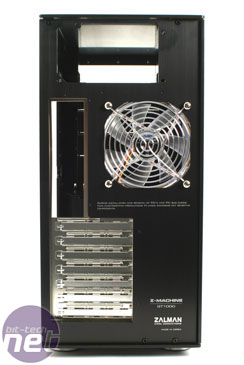
Noise:
Noise on the other hand is a different matter. In the first configuration, with the back fan on 12V and the front fans on 5V, the case isn’t much more noisy than you’d want it to be. There’s still an audible hum coming out of the aluminium shell, but it’s never overpowering and could easily be drowned out by a little music or game play.Shifting the fans into the other configuration however, with the front fans on 12V and the back fan on 5V, proves to be a lot noisier though. An awful lot noisier. Seriously, the case sounds like a wind-tunnel and it’s surprising that the fans themselves didn’t start smoking with the speed.
Of course, there’s very little reason to use this second configuration as the heat performance tests proved that the case handled heat better if it was left with the front fans on a lower voltage and the back fan was left to do all the high voltage work. If you really need the extra RPMs then there is the middle ground of setting each front fan to a different voltage, but we don’t really see the benefit and it would make more sense to just add an extra case fan on the spare connector.
Conclusions
We’ve checked the outside, we’ve checked the inside, we’ve tested the case in three categories and we’ve slipped with a screwdriver and cut ourselves accidentally twice in the process. Now, what do we think of the Zalman Z-Machine GT1000?Well, we still think that the name is needlessly long.
The case itself though is even more impressive than our initial impressions lead us to believe. Not only does it look good to the eye, but the build quality is through the roof thanks to some thick, removable aluminium panels and the tight fit of the individual components.
The insides of the case are good too, providing extra room for storage addicts and a motherboard panel that can be completely detached from the main body. There are some weak points, such as the lack of cushioning on the doors and an absent PSU shelf which puts too much weight on the supporting screws, but it’s obvious that a lot of thought has been put into the design and, again, the sturdy quality of the case compensates for the handful of oversights.
In performance testing the case proved itself yet again, with only minor installation problems appearing and a solid heat performance
 revealing the excellent ventilation. In terms of noise, there are a few concerns and the case is by no means silent, but it isn’t exactly noisy either and the gentle hum of rotating blades and thrumming components isn’t enough to make you miss that vital headshot in CS:S.
revealing the excellent ventilation. In terms of noise, there are a few concerns and the case is by no means silent, but it isn’t exactly noisy either and the gentle hum of rotating blades and thrumming components isn’t enough to make you miss that vital headshot in CS:S. So, we’re down the final test – price. Just how much does the Zalman Z-Machine GT1000 cost?
Well, this is where the bad news begins. In the UK the GT1000 is going to set you back at least £259, which is an awful lot for a PC case which isn’t made out of solid gold or custom engraved for you. In the US then prices are usually around the $359 mark, which is likewise an incredible amount to spend on what is basically an aluminium box.
Just think; you could buy a second graphics card for the cost of this case.
The extravagant price is still kind-of acceptable though as the case does look beautifully elegant and comes with a fair few features which will be appreciated by the hardcore PC enthusiast, which is exactly who this case is aimed at. The case performs excellently too, with decent ventilation and lots of easily removable panels for quick access to the motherboard.
The Zalman Z-machine GT1000 isn’t the best PC case I’ve personally ever looked at, but it’s certainly very close and the design may be well suited to those who didn’t like the style of the Antec P190. Just remember that the P190 is still a little cheaper than the GT1000 and that comes with two PSUs provided.
- Build Quality
- x
- x
- x
- x
- x
- x
- x
- x
- x
- x
- 10/10
- Ease of Use
- x
- x
- x
- x
- x
- x
- x
- x
- x
- -
- 9/10
- Features
- x
- x
- x
- x
- x
- x
- x
- x
- -
- -
- 8/10
- Performance
- x
- x
- x
- x
- x
- x
- x
- x
- x
- -
- 9/10
- Value
- x
- x
- x
- x
- x
- x
- -
- -
- -
- -
- 6/10
- Overall
- x
- x
- x
- x
- x
- x
- x
- x
- -
- -
- 8/10

MSI MPG Velox 100R Chassis Review
October 14 2021 | 15:04










Want to comment? Please log in.